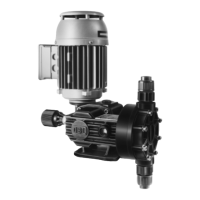4
15
4.4
➜
➜
➜
➜
➜
➜
SOLUTIONSCAUSES
• Incorrect wiring: Check.
•
Overheating due to pump working pressure higher than allowed:
Check max. discharge pressure by means of a pressure gauge
fitted on the discharge pipeline.
• Pressures higher than allowed: (see max. pressure indicated on pump rating plate) reduce the
discharge pressure or install a dampener in case of excessive
narrowing on the discharge pipeline.
• Stresses on pump flanges: Loosen the pipes connected to the pumphead
and check.
• Discharge pipeline clogged or valve shut: Check.
• Back pressure valve set to a pressure higher Check.
than allowed:
• Oil level in the gearbox is low: Add suitable oil. See table F, page 10.
OVERHEATING OF PUMP BODY AND MOTOR
MAINTENANCE
SOLUTIONSCAUSES
SOLUTIONSCAUSES
• Air enters the suction piping through the fittings:
Check.
• Air trapped inside the pump:
For a short while, keep flow rate to maximum
.
• Excessive suction head lift:
Reduce it.
• Vapour pressure of the liquid too high:
Increase hydrostatic head on suction side.
• Pumping temperatures too high:
Increase hydrostatic head on suction side.
• Viscosity of the liquid too high:
Install a suction piping of larger diameter. Increase hydrostatic
head on suction side.
• Feed tank hermetically sealed and with no vent:
Make a vent in the tank upper part.
• Suction piping clogged or valves shut
Check.
• Filter on suction side clogged:
Clean it.
• Pump valves jammed because of dirt:
Dismantle the valves and clean them carefully.
• Safety valve setting pressure too low:
Check.
• Suction pressure higher than discharge pressure: Increase the discharge head of at least 0,3÷0,5 Kg/cmq
(3÷5m) respect to the suction pressure.
• Back pressure valve stuck in open position because of dirt
or setting pressure too low: Check.
• Pump valves jammed in open position: Check.
FLOW RATE IRREGULAR OR HIGHER THAN EXPECTED
FLOW RATE LOWER THAN EXPECTED
OPERATING TROUBLES

